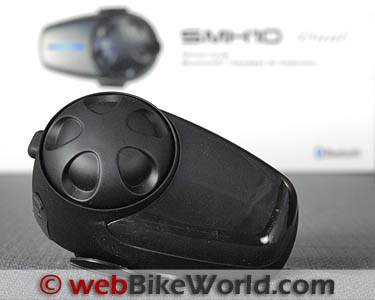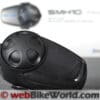I loaned Chris another Sena SMH10 intercom pair for his latest adventure, a trip on the Trans-America Trail.
This was the latest version of the SMH10, with the most recent firmware update.
Chris is an experienced intercom owner and user but has limited experience with Bluetooth intercoms, so this is an interesting report from that perspective.
A Long-Distance Trip
It was just a year ago when my friend Glen spent two weeks riding the Trans-Labrador Highwayusing a set of Sena SMH10 intercoms on loan from webBikeWorld.com.
With the success of that trip still in our minds, the goal of riding the Trans America Trail (TAT) came to life this summer.
Once again Rick offered us the use of another pair of Sena SMH 10 intercoms, this time with the newer style “micro” cable connector plugs and intercom modules that could be up-graded to theSena SMH10 4.0 firmware (report).
Firmware, software? I have no idea what the difference is, but I was game to try them, especially since the offer was made.
As I said in my first report, “You don’t look a gift horse in the mouth.” As with our trip on the TLH, being able to communicate via an intercom was invaluable…
Updating the Sena SMH10
Be sure to read my report on the earlier version Sena SMH10 intercoms (report) we used on the Trans Labrador Trail ride, because I will only be pointing out changes we noticed from the previous firmware to the present and any other issues that we encountered during our latest adventure.
For a more in-depth description of the operation and features of the SMH10 intercoms please see the webBikeWorld Sena SMH10 review.
Rick dropped off two complete SMH10 intercoms one evening prior to our departure, along with a boom mic extension kit which I needed for fitting a set into my HJC SyMax II (review). Since we had had problems with the stick-on mounting brackets last year I finagled the clamping mounts into both of our helmets this time, which gave us no troubles throughout our journey.
This was a good thing because the Trans-America Trail had more than a few surprises in store for both of us!
Both modules needed to be up-dated with the latest 4.0 Firmware which was easily accomplished online using the included USB cables. Actually, each of the newer modules came with two cables; one that had a standard USB plug on one end, the other with a 12 volt cigar-lighter-style end, both of which can be used to charge the modules.
This was a good thing because once again, we would have charging “issues” along the way, none of which were the fault of either Sena SMH 10 units.
Firmware Update Details
First I had to download a small “SMH 10 Manager” program from the Sena website, after which it was a simple matter of following the instructions; first registering the units (not required, but recommended) then up-grading to the 4.0 firmware.
I didn’t record the time it took, but it wasn’t long at all, even for someone like me, who is not as electronically savvy as H.B.C., the resident Bluetooth intercom guru here at webBikeWorld.
As on our previous trip, we would only be using the Sena units for bike-to-bike communications, although I did pair it with my phone for grins one evening just to see how well it worked, but had no intentions of using that option while riding.
Even though I was less than impressed with the VOX performance with the previous firmware, I did activate the VOX on these units to see if there had been any improvements. Sadly, I must say there were none, so most of the time we simply left the intercoms “open”.
The weather this time around was very dry with lots of dust and it was very hot — as in 100+ degrees almost every day. We did have a half-day of light rain, but that was it for the trip.
OK, so how did the 4.0 firmware compare with the older version of the firmware we used on the Trans-Labrador Highway adventure?
Battery Life
As with my previous report, I’ll start off with the battery life, which was very impressive. Despite the “open” intercoms and considerable chatter — back-and-forth talking between Glen and I — the batteries lasted the better part of the first two days — and that’s from 6:30 a.m. to 5 p.m.
They were turned off if we stopped for anything longer than a fuel stop, but most of the time they were left on. Although we had intended to camp each evening, it was so stinking hot we “motel-ed” it after the first night, so the intercom modules were charged each evening with the included 110 volt adaptor and USB cord.
For weight and space reasons, I took only one 110V adaptor, so one intercom module would usually get a full overnight charge, and the other several hours. There was only one occasion in two weeks when either of us heard the low charge tone.
Range
Glen and I were in agreement that the range seemed less than the claimed 900 meters we experienced last year and as before it was limited to line of sight. If the other rider rode around a bend or there was any type of obstruction (i.e., a large bush, rock, etc.) between us, the connection would be lost.
This leads me to a really big disappointment of the 4.0 firmware upgrade. Whenever we began to reach the range or visual limits, the intercoms would begin to emit the most obnoxious noises through our speakers which I can only describe as an electronic twanging or string like sound.
Unlike the “hiss” sound we had last year, this noise was absolutely maddening to both of us. This was a constant occurrence because the navigation process of following the Trans-America Trail roll charts often had one of us waiting at an intersection of multiple trails while the other headed down one to see if the GPS agreed with that direction.
Also, when ever we were in a wooded area and lost visual contact that noise would start and continue until the connection re-established. As I said, this was absolutely maddening.
Other Issues
Rick had mentioned that Sena is planning on eliminating the pins that protrude out the back of the modules (in future versions of Sena intercoms) and make contact with the bracket on the helmet and thus with the microphone and speakers within the helmet.
Although we never had a problem with them last year, we did this time. A day or two into the trip Glen noticed that one of the speakers in his helmet quit working. The next morning I swapped the modules between us and not long afterwards lost sound from the same side speaker.
I noticed that if I touched the module lightly on one end the sound would return, thus convincing me that the problem was between the pins on that particular module and the bracket on our helmets. I guess this is why Sena is looking at a design change…
Conclusion
Having the ability to communicate while riding is a great asset especially without the encumbering wires associated with a hardwired intercom. Today’s Bluetooth systems offer amazing options for interconnecting other electronic gizmos and are constantly improving.
For me personally it has to perform as an intercom first and foremost. Perhaps as a rider to passenger intercom, or only for the rider, the Sena SMH 10 with the 4.0 firmware update does well, but as a rider-to-rider communication device, it comes up short.
Sadly, I have to say, I found no improvements with the 4.0 firmware update; in fact, it was rather the opposite. Maybe I can talk Rick out of different brand intercom for Glen’s and my next big “Adventure”…
Also: Part 1: Sena SMH10 on the Trans-Labrador Highway
Owner Comments and Feedback
See details on submitting comments.
From “S.K.” (November 2012): “I’m going to buck the trend here and say that these units (we have three) are by-and-large a disappointment. Having ridden together for nearly thirty (oops!) years with just hand-signals between our bikes, my life-long riding buddy (my wife) and I think we’ll ditch the intercoms for a while and come back in another 30 years to see if they’re improved any.
We bought these from the local Australian importer (whose after-sales back-up is a shining advertisement for buying off the internet and from ANYWHERE else!) and paid full price (almost $600) for three full set-ups, after much research concluded that these were the crème-de-la-crème. All upgrades and updates have been performed whenever they become available.
The good: Answering the phone while on the move is one-button easy and crystal-clear for user and caller; in fact, almost no-one could tell I was on the bike. Whether that’s a function of the Sena’s microphone, the screen on my Aprilia or the way my fat head fills my Multitec is moot.
Having the theme from the Twilight Zone as a ring-tone is pretty cool too. No, I didn’t choose it — that’s just the way it is.
The not-so-good: Charging takes forever. We have three charge sockets on each bike which can be used when we park up, but between 3 x Senas, three phones, a GPS, an iPod and a camera, things can get a little confused — and of all of them, the Senas take by far the longest to recharge. Best is to leave them plugged in overnight; each bike has a USB power socket under the seat, so that gets two of them charged up while out of sight, anyway.
Also, like many dual-sport riders, I wear a textile jacket with CE armour inserts; I find that lifting my left arm up to shield my eyes from the sun for example, will often cause the shoulder of my jacket to depress the large dial on the Sena, triggering (or cutting off) the intercom.
The bad: Range between bikes is claimed at 900 metres and we have NEVER achieved audible speech over that distance; half as much is about all we can manage (and I’m a professional narrator, so my diction isn’t bad!). Line-of-sight is vital — if there’s a car between us, we lose about 50% of the range or clarity. I’d challenge anyone to hear what is being said in this Bluetooth intercom over 500 metres.
The absolute worst: Constant interference between units that is distractingly tiring, and therefore dangerous. Mostly it’s a faint but distinct clattering, a bit like the opening few seconds of “The Road to Hell” (how very appropriate!); sometimes it sounds a bit like a room-full of old-fashioned typewriters at the end of a long passage. That’s if we’re reasonably close together.
Build up any distance and there’s a rising hiss of static-type interference like on an old-fashioned radio. In trying to solve this, and wondering if the interference was brought on by anything on our bikes, or by metallic objects nearby, we wandered around our garden, away from walls, buildings, metal roofs and any sources of electrical “noise”.
The interference remained unchanged. It doesn’t matter which two of the three units are in use, the interference is constant (but NOT present if we use the units individually, on a solo ride or commute. In busy traffic, the constant noise is draining and saps concentration when you need it most, so we turn them off — which rather defeats the object of having them.
We’re better off with hand-signals.”
From “M.A.” (August 2012): “We’ve been using our newly updated SMH10’s as well with exactly the same results as found in this review — the range is no better, (IMHO it’s subjectively worse) and the tweedle noise generated when the two units get too far apart is quite distracting.
I’m thinking of returning the new units and going back to our original SMH10 units (without the upgrade option). Hopefully Sena will decide to change the tone generated when the units go out of range, and even better, extend the range overall as we really enjoy the quality of the audio when using the intercom circuit.”














